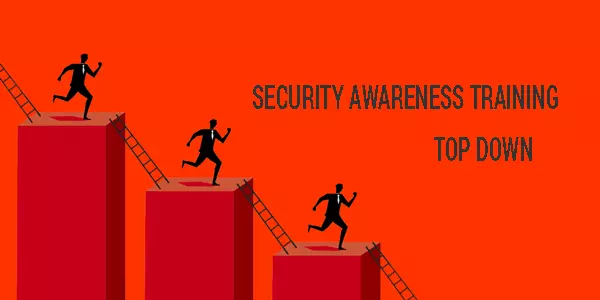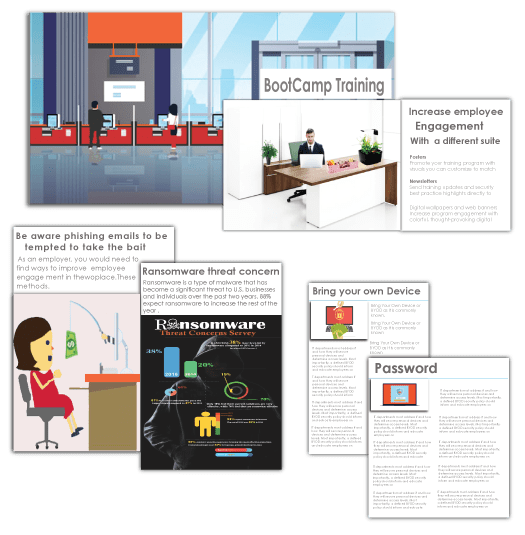Understand the security and technology field they use. Be aware of the threats companies face. Understand how threats can affect their business. Be aware of the risks associated with the use of remote Access technology and the use of mobile devices. Be aware of the implications of social media. Understand the risks of improper management of personal and organizational data. Know what to do if data is stolen.
-
About this course
Within an organization, it is essential that the C-Levels (Directors, Executives, Managers, Chiefs understand that they are continuously exposed to cyber-attacks performed to extract information from the companies they work for. Therefore, it is important for C-levels to be properly trained and prepared.
-
Why should you take this course?
As an executive, it’s important for you to understand a harsh and terrifying reality: Your company is under constant attack from hackers, thieves, and other cybercriminals. They are looking for a way into your network so they can steal information or money, spy on you, and possibly cause havoc up and down the line. And they are using you and other high-level executives as bait.
-
What will you learn by taking this course?
Security awareness training is the process of providing formal cybersecurity education to your workforce about a variety of information security threats and your company's policies and procedures for addressing them.
-
Chapter 1: Basic Components
✔️ Understand the security and technology field they use.
✔️ Understand how threats can affect their business.
✔️ Be aware of the implications of social media.
✔️ Understand the risks of improper management.
✔️ Be aware of the threats companies face.
✔️ Be aware of the risks of remote Access technology
✔️ Know what to do if data is stolen.
-
Chapter 2: C level is designed to help executives and board members manage their cyber risk.
✔️ Cyber risk reality and the role of the board of directors.
✔️ 10 critical questions risk assessment answers.
✔️ 5-step cyber risk framework.
✔️ Post-assessment action plan to help prepare for unknown.
-
Do mobile devices present security risks?
Mobile breaches can lead to data theft, surveillance, and the hijacking of devices. Mobile malware can steal data, conduct surveillance, and even perform malicious advertising. It can also hide undetected on devices for some time What are the top five barriers in addressing cybersecurity?
-
What capabilities are necessary components of a cyber security strategy?
Here are three elements your cybersecurity strategy needs.
✔️ Clearly Defined Security The foundation of your security strategy must be rooted in your organization's security goals and objectives. ...
✔️ Communication with Executives and Key ...
✔️ Proactive Threat Management.
-
Why do I need to worry about information security?
The threats are real – and it’s not some shady character with a gray hooded sweatshirt looking at scrolling lines of green code. From a volume standpoint, it’s largely automated and in a general broadcast to large swaths of the Internet (although the most significant threats are targeted). Cisco Talos has hard statistics on the fact that roughly 85% of all email traversing the Internet is spam – either marketing or malware. The spam filters do a good job at catching and stopping that 85% but some are bound to go unnoticed and pass through to your users.
-
What are the biggest cybersecurity threats right now?
Without question, wire transfer fraud and ransomware headline the most critical threats facing organizations.
Wire transfer fraud occurs when a manual bank transfer occurs to transfer funds between entities. Attackers compromise an organization’s email system and start looking for finance and payment-related employees. Our Incident Response team sees attackers lurk in the email for months waiting for a payment to compromise. Then the two entities exchange emails with payment info, they will insert a second email making it seem like there was a transcription error and to please use the new account number (or take the exchanged credentials and attack the bank account directly). They then divert the transferred money out of the fake destination before anyone notices. There are other flavors of this type of attack, but this example demonstrates the need for authenticated verification of wire transfers that use multiple mechanisms to prevent this type of theft.
- Key Features:
- Created by a Security expert :
- Access period : 12 months
- Course duration : 40+ hours
- Quizzes & revision exams :
- Certificate of completion :
- Support : 24/7 hours

Why security awareness training to your C-level executive

As a C-level executive member you need to understand adequate about cyber security so you can have a confident conversation with your experts. These days cyber Security is everyone’s problem. With cybercrime damages expected $6 trillion by 2021, it is hardly surprising that cybersecurity has become a C-level executive and board-level hot topic now a days. The C-level executive members are responsible for implementing of a sound cyber security program, including the overall guidance and direction of setting a cultural value related to risk awareness, policy and strategy, defining risk profile and creating security initiatives and priorities for organization.
The Cybersecurity Threat in the C-Level
CEOs the greatest cyber-security threat to the enterprise
You’ve been hacked, and it’s generating big headlines. What happens next, now that your board and the media are asking who’s going to pay? If history is our guide, it’s probably your CEO; in the event of a major breach, the buck usually stops with your top guy.
If you’re like many CEOs we meet, you assume cyber risks are best left to the experts and you have these experts in your IT and cyber-security departments.
But the reality is that no amount of delegation will shield you from the personal consequences of a cyberattack. Following a breach, parties whose information is stolen, or whose lives are otherwise impacted, look for someone to blame. And they don’t look to your technical experts or security vendors. Upset politicians and incited media don’t blame a faulty firewall.
They look at you, the CEO. And they don’t care who you put in charge of cybersecurity.

Why is cybersecurity important to the C-level executive?

Cybersecurity is no longer something that only impacts your IT department or Information Security team. When a security incident hits an organization, it can cost USD 3.92 million – this being the average cost of a cyber-attack in 2019. Data breaches can cause devastating financial losses and affect an organization’s reputation for years. Many of the costs incurred by a security incident are indefinable. Loss of brand loyalty, for example, is difficult to qualify in the long term and costly to reinstate, once lost.
Being a C-level executive member, you will be targeted always
Senior executives, C-level executive or stakeholders in organizations are regularly the target of cyber-attack by cyber-criminal, because of their access to valuable assets and also their influence within the organization.
Implementing cyber security awareness program, security policies will help to mitigate cyber risk. It is critical that C-level executive members and stakeholders must understand and follow their organization’s cyber security policies, so that when a cyber-criminal tries to manipulate them, staff can identify that something is unusual.

It takes time to educate the C-level executive of your company. You need to take action. You can’t wait for actions to be taken

Training the C-level executive members on security issues at any organization is a real challenge and is a double edge sword of very little time and high level of commitment. Aspire Tech designed an effective training for C-level executive members and it very simple, short and conducted on an annual or semiannual basis. Once they are properly trained (and we mean every member of the C-level executive), they can then align the rest of the business.
At C-level executive advisory training, we will :
- Present easy-to-understand industry and business-specific cyber-security threats and risk management strategies
- Identify security challenges for an organization
- Advise you on cyber-security governance and compliance
- How to develop cyber-security framework for your organization
We will help you translate this information into actions and provide relevant feedback to help your C-level executive and board make informed decisions.
Security awareness training top down
The fix for modern cyber-security issues is about people as much as it is about technology. Your C-level executive, board and stakeholder must become a catalyst for change by setting the tone for security at the top. As regulations tighten up on the C-level executive members around duty of care, now is the perfect time to involve security awareness training to your board. In fact, the tone for cyber-security awareness must begin at the top.

How can you involve security awareness to your C-level executive members?

In a 2016 Ponemon Institute study, which looked at risk management, they found that 63% of executives felt they did not have accountability or responsibility for cyber security. The study also found that 50% of respondents felt that risk management was not aligned with business goals and that C-level executive were not engaged in the process. There needs to be a shift in perception to accommodate a shift in strategy to then mitigate cyber-risk.
We work with you
C-level executive who take cyber security risk seriously are uniquely positioned to help board and management tackle cyber-security risk. When you partner with us, you benefit from our extensive knowledge and skills as we develop your business’s cyber security, from C-level executive. As one of top cyber-security firm, we offer nearly 30 year’s experience in the technical, commercial and regulatory aspects of cyber security.
Aspire Tech Services and a Solutions is a leader of next-generation information technology (IT) services and solutions. Our mission is to enable superior returns on clients' technology investments through best-in-class industry solutions, domain expertise and global scale. The company is well known for its excellent challenge management skill on IT sectors which leads towards high customer satisfaction, best quality of work and add value to the commitment made to the clients.

COURSE MODULE ROLE BASED TRAINING FOR C-LEVEL

Duration:
- 8/40 Hours
Ways to Learn :
- Virtual Training
- Virtual Instructor-Led Training
- Classroom Training
Course Audience:
- Intended for Managers
Course Language :

Course Topics:
Chapeter 1: Basic Component
- Understand the security and technology field they use
- Be aware of the threats companies face.
- Understand how threats can affect their business.
- Be aware of the risks associated.
- Understand the risks of improper management.
- Know what to do if data is stolen.
Chapeter 2: C-Level cyber risk complement
- Today’s cyber risk reality and the role of executives
- 5-step cyber risk framework.
- 10 critical questions a cybersecurity risk assessment.
- Post-assessment action plan to help prepare.
The key training board messages and approach should include

- A thorough understanding of changes in regulatory issues and impacts and changes in business as it relates to the overall practices at a bank or financial institution.
- An effective understanding of security as it relates to the enterprise risk model from a high level.
- Realistic feedback on what the highest risk policy and processes are? And where are the security vulnerabilities within the institution?
- Understand the impact of security failures on the business and the potential effect on stakeholders, competition etc. What are the real costs involved?
- Focus in ensuring that security initiatives and improvements are measured and monitored on a regular basis and all are part of an evaluation process.
- Develop and implement an effective security policy and procedure, ensuring that proper security tasks and initiatives are assigned to management appropriately
- Have up-to-date knowledge on the regulatory and business practices that govern the institution's day-to-day operating environment
- Develop high level of awareness regarding risk and security exposure
- Adopt a hands-on role in managing and getting involved with security related decisions
- Define who is responsible for security in their institution and pushing this responsibility to the individual employee level.
- Monitor management's performance in effectively managing security risks
- Develop crisis management practices
What does C-Level Executive mean?
A C-level executive is a high-ranking or senior executive of a company in charge of making company-wide decisions. The "C" stands for "chief" since a C-level executive (also called C-level exec or C-suite executive) is in charge of a business unit or department (e.g. Human Resources, Security, Marketing, etc).
Some best-known C-level executives in U.S. companies include :
- Chief executive officer (CEO)
- Chief operating officer (COO)
- Chief marketing officer (CMO)
- Chief financial officer (CFO)
- And chief information officer (CIO)
Other C-level titles related to IT include :
- Chief security officer (CSO)
- Chief technology officer (CTO)
- And the chief green officer (CGO)

Who should take this course?
The course is designed for c-level member in the organization. So, all you guys out there which include those whose designations start with “Chief” like CFO, CIO, CTO, CFO, CMO, COO, and CFO.
Security Awareness Training is more important now than it has ever been. Data breaches and hacking may sound unlikely, but cyber-attacks occur daily. In many cases, businesses are unprepared, because management does not understand the risk. Many companies believe they will not be the target of an attack. The truth is that all companies must prepare for a cyber-attack by having an individual or team in place to protect from such an attack.

Boost Engagement with delivering Communication Tools

Increase employee engagement with a different suite of communication tools like:
Posters
Promote your training program with visuals you can customize to brand... more
Newsletters
Send training updates and security best practice highlights directly... more
Digital wallpapers and web banners
Increase program engagement with colorful thought-provoking messaging... more
Training Videos/Animations
Strengthen key awareness concepts and skills through stylish visual... more
Why Aspire Tech
Award-winning courses
Aspire's award-winning online courses and programs are created and delivered by a renowned Cyber Security specialist.
The perfect fit for business
Plans for small to large businesses that are flexible to match your budget. There is a volume discount available.
Cost effective training
For a fraction of the expense of traditional classroom training, train thousands of employees in numerous locations.



